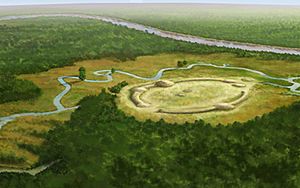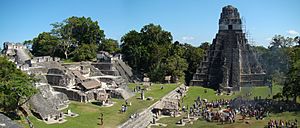List of pre-Columbian cultures facts for kids
This article is about the many amazing cultures that existed in the Americas before Christopher Columbus arrived in 1492. These are often called pre-Columbian cultures. They built huge cities, developed farming, and created complex societies.
Contents
Ancient American Civilizations
Many early American civilizations built permanent towns or cities. They also started farming and created societies with different levels of people, like leaders, farmers, and craftspeople.
In North America, some of the oldest known structures are mounds built by Native American groups in Louisiana. These mounds, like those at Watson Brake, date back to about 3500 BC. This makes them the oldest known multi-mound complex in the Americas! These early builders were hunter-gatherers, meaning they hunted animals and gathered plants for food. They didn't use pottery yet. Later, other mound-building cultures like the Poverty Point culture appeared.
Many of these ancient civilizations had already ended by the time Europeans first arrived in the late 1400s and early 1500s. We know about them mostly through archaeology, which is the study of old things dug from the ground. We also learn from stories passed down by Native American nations today.
Other civilizations were still thriving when Europeans arrived. We know about them from historical records written at the time. Some groups, like the Olmec, Maya, Mixtec, and Nahua, even had their own writing systems. Sadly, many Europeans at the time thought these writings were wrong and burned most of them. Only a few documents were hidden and survived. These give us small clues about their ancient cultures and knowledge.
From both Native American and European records, we know that these civilizations had impressive cities. They also had advanced knowledge of astronomy (the study of stars and planets) and mathematics.
Even today, the descendants of these ancient societies continue to adapt and grow. They still keep many traditions and practices from these earlier times, often mixed with newer ways of life.
Some ancient civilizations, especially the Aztecs, practiced human sacrifice as part of their religion. Other Mesoamerican groups, like the Maya and Zapotec, also did this. How much it happened is still debated by historians today.
Cultures of Northern America
These are some of the important cultures that lived in what is now North America:
- Paleo-Indians (about 18,000–8000 BC)
- Archaic Period (8000–1000 BC)
- Watson Brake and other mound sites in the Lower Mississippi Valley (3500 BC–2800 BC)
- Poverty Point culture (2200 BC–700 BC)
- Later Cultures (1000 BC–onward)
- Southwest
- Ancestral Pueblo culture (1200 BC–1300 AD) – sometimes called Anasazi
- Hohokam (1 AD–1450 AD)
- Eastern Woodlands
- Woodland period (1000 BC–1000 AD)
- Adena (1000–200 BC)
- Hopewell culture (200 BC–500 AD)
- Mississippian culture (800 AD–1730 AD) – these groups built large earth mounds
- Caddoan Mississippian culture (1000 AD–1650 AD)
- Plaquemine culture (1200–1730 AD)
- Woodland period (1000 BC–1000 AD)
- Southwest
Cultures of the Caribbean
Here are some of the early cultures that lived on the islands of the Caribbean Sea:
- Ortoiroid people (about 5500—200 BC)
- Ciboney people (about 1000—301 BC)
- Saladoid culture (500 BC—545 AD)
- Arawak people (about 500–1500 AD)
Cultures of Mesoamerica
Mesoamerica is a historical region that stretches from central Mexico down through parts of Central America. Many important civilizations developed here:
- Aztec (1325–1521 AD) – a powerful empire in central Mexico
- Maya (2600 BC–1697 AD) – known for their writing, math, and huge cities in Mexico and Central America
- Mixtec (unknown–1600 AD) – lived in western Oaxaca, Mexico
- Olmec (1500–400 BC) – one of the earliest major civilizations in Mexico, known for giant stone heads
- Purépecha Empire or Tarascan state (1300–1530 AD) – a strong empire in Michoacán, Mexico
- Teotihuacán (200 BC–800 AD) – a huge ancient city near Mexico City
- Toltec (900–1100 AD) – a powerful culture in central Mexico, though some think they might be mythical
- Zapotec (500 BC–1500 AD) – lived in Oaxaca, Mexico
Cultures of the Isthmo-Colombian Area
This area includes parts of Central America, like Panama and Costa Rica:
- Cueva people (?-1530 AD) – lived in Panama
- Diquis culture (700–1530 AD) – known for their stone spheres in Costa Rica
- Gran Coclé (1200 BC-1500 AD) – lived in Panama
Cultures of South America
Here is a table showing some of the many cultures that lived in South America, organized by time period:
| Period | Dates | Cultures |
|---|---|---|
| Ceramic Period (when pottery was used) | ||
| Late Horizon | 1476 AD – 1534 AD | Inca Empire (Ecuador, Peru, Bolivia, Argentina, Chile, Colombia); Muisca Confederation (Colombia); Diaguita (Argentina) |
| Late Intermediate | 1000 AD – 1476 AD | Aymara kingdoms (Bolivia); Chimú (Peru); Manteño (Ecuador); Muisca (Colombia) |
| Middle Horizon | 600 AD – 1000 AD | Tiwanaku (Bolivia); Marajoara culture (Brazil); Huari (Peru); Quimbaya (Colombia) |
| Early Intermediate | 200 AD–600 AD | Moche (Peru); Nazca (Peru); Tiwanaku (Bolivia); San Agustín (Colombia) |
| Early Horizon | 900 BC–200 AD | Chavín (Peru); Paracas (Peru); La Tolita culture (Ecuador) |
| Initial Period | 1800/1500 BC – 900 BC | Chavín (Peru); Machalilla culture (Ecuador) |
| Preceramic Period (before pottery was used) | ||
| Period VI | 2500 BC – 1500/1800 BC | Norte Chico civilization (Peru, including Caral); Valdivia culture (Ecuador); Chinchorro culture (Peru, Chile) |
| Period V | 4200 BC – 2500 BC | Norte Chico civilization (Peru); Valdivia culture (Ecuador); Chinchorro culture (Peru, Chile) |
| Period IV | 6000 BC – 4200 BC | Chinchorro culture (Peru, Chile) |
| Period III | 8000 BC – 6000 BC | Las Vegas culture (Ecuador); Chinchorro culture (Peru, Chile) |
| Period II | 9500 BC – 8000 BC | El Inga culture (Ecuador) |
| Period I | ? BC – 9500 BC | El Abra (Colombia) |
See also
 In Spanish: Anexo:Culturas precolombinas para niños
In Spanish: Anexo:Culturas precolombinas para niños
- Mississippi culture
- Indigenous peoples of the Americas – to learn about Native American peoples today
- Pre-Columbian Brazil
- Pre-Columbian Ecuador
- Pre-Columbian cultures of Colombia
- Ancestral Puebloans





